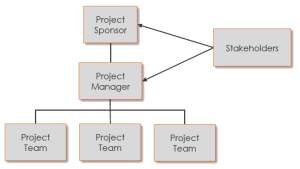
The Project Management Institute (PMI) defines project management as follows:
- The application of knowledge, skills, tools, and techniques to project activities to meet project requirements.
The profession of project management includes the application of many skills, which include:
- Dividing the project into tasks
- Creating schedules (deadlines)
- Estimating budgets
- Determining project scope
- Communicating with stakeholders
- Acquiring the project team
- Developing and mentoring the project team
- Ensuring the availability of resources
- Ensuring high quality deliverables
- Monitoring and controlling change
Project Management Plan
According to the Project Management Body of Knowledge (PMBOK) published by PMI, the project manager develops a project management plan which is approved by the project sponsor. During the project, any changes are re-approved by the project sponsor and recorded in the project’s change log.
The project management plan contains the following items:
- Scope statement
- Deliverables
- Success factors
- Schedule
- Budget
- Quality standards
- Project team needs – positions, job descriptions, etc.
- Stakeholder list
- Procurement plan
- Risk analysis
The Project Manager
The definition of a project manager is:
- The person assigned by the performing organization to lead the team that is responsible for achieving the project objectives.
 They are responsible for the day to day activities of the project. They are separate from a functional manager who is responsible for a business unit, or an operations manager who is responsible for a series of ongoing activities.
They are responsible for the day to day activities of the project. They are separate from a functional manager who is responsible for a business unit, or an operations manager who is responsible for a series of ongoing activities.
For example,
- A project manager is in charge of a paving project (a temporary, unique endeavor)
- An operations manager is responsible for maintaining the road network
- An engineering manager is a functional manager who is in charge of that department.
The project manager could report to either of these types of managers, but their responsibilities end at the project.
The project manager is ultimately responsible for the success or failure of the project, although they often share some of that responsibility with the project sponsor.
The person one level above the project manager is called a project sponsor. They are not involved with the day to day activities of the project, but they are usually familiar with the project status. They often approve changes to the project, as well as manage the project’s funding. They accept the project’s deliverables. Often they were the project’s champion that promoted the creation of the project. In the example above, the project sponsor would be someone working for the agency (state, province, etc.) who established the paving project as a priority for the agency and brought it to fruition.
Definition of a Project
The PMBOK defines a project like this:
- A temporary endeavor undertaken to create a unique product, service, or result.
Very simple and to the point, but the two words that encapsulate what a project is and isn’t are:
- Temporary: Projects have a defined beginning and end. Because of this, the variables of time (deadlines) and money (budgets) are fixed as well. Or at least they should be. These two variables are the core variables inherent in all projects.
- Unique: Theoretically, all projects are different from on another. Even if you were to have two projects, one which produces 25 widgets for a certain customer and another that produces 25 more widgets for that same customer, those are two separate projects because they have different schedules. You cannot call them 50 separate projects because they would be identical and that would be an operational (ongoing) activity.
Project Life Cycle
The following is the project life cycle according to the PMBOK.
- Project Initiation. The tasks involved with the creation of the project, including initial funding and authorization of the project manager.
- Project Planning. The production and approval of the project management plan.
- Project Execution. The performance of the project’s work, and production of the deliverables.
- Monitoring & Controlling. Controlling the project to ensure it continues to adhere to the project management plan.
- Project Closing. Finalizing the project and releasing project resources.
The PMBOK uses the technical term process groups to describe these phases. They are generally in chronological order but the project can sometimes revert back to a previous phase. For example, when the paving project is finished the construction of concrete curbs, some tasks might have to be performed before the paving begins that are considered planning.
Project Management Documents
Professional project management according to the PMBOK requires a project manager to produce various documents which assist in the planning, execution, and control of the project. The following list can be sufficient for small projects:
| Phase | Document |
|---|---|
| Initiating |
|
| Planning |
|
| Execution |
|
| Controlling |
|
| Closing |
|
These documents are described below:
- Project Charter
Although it is optional for small projects this document is the only one in the initiating phase. It authorizes the project and assigns the project manager. It provides overall guidance as to the business case for the project, the major deliverables, and why the project was created. It is “above” the project and thus primarily the responsibility of the project sponsor. - Project Management Plan
One of the biggest tasks of the project manager is the development of the project management plan. It serves to establish the official project plan, including scope, schedule, budget, and any other item of concern to the stakeholders. The baseline established within the project management plan then becomes the basis for project control. - Project Status Reports
Regular status reports are necessary to keep the project stakeholders informed and disseminate the project status. The earned value metrics are used to communicate the project’s schedule and budget progress, as well as the project manager’s commentary on the issues being worked on are important as well. - Stakeholder Communication
Each project stakeholder tends to have regular communication needs which are defined within the project management plan and executed throughout the project, for example, the approval of deliverables, investor circulars, etc.). But inevitably each stakeholder needs to be communicated with on an ad hoc basis on various project issues. The important communications should be recorded in a project communications file to ensure nobody changes their minds or is misunderstood. - Change Logs
The project management plan is the official project plan, approved by the project sponsor. When the actual project performance differs from it, a change needs to be made to the plan. The project sponsor needs to re-approve the project management plan and the changes need to be entered into the project’s Change Log. This is often simply a table within the project management plan itself. At the end of the project the changes can be reviewed to determine the lessons learned for future projects. - Variance Reports
The project status reports, above, include the earned value metrics, or at least the schedule-related ones (the budget-related ones can be kept separate if an external organization, for example a consultant, is managing the project). But the calculation of the earned value metrics themselves is not limited to project status points. Therefore the project’s internal variance reports are integral to making sure that early action can be taken when the project leaves its schedule and/or budget baseline. - Project Closure Report
The value of a closure report is in the actual schedule and cost metrics. For future projects it is extremely helpful to have a task by task breakdown of how long each task took and how much it cost. This is called analogous estimating, and it is the most reliable form of estimating. Unique and unusual items that were present in each task should be documented.











Leave a Reply